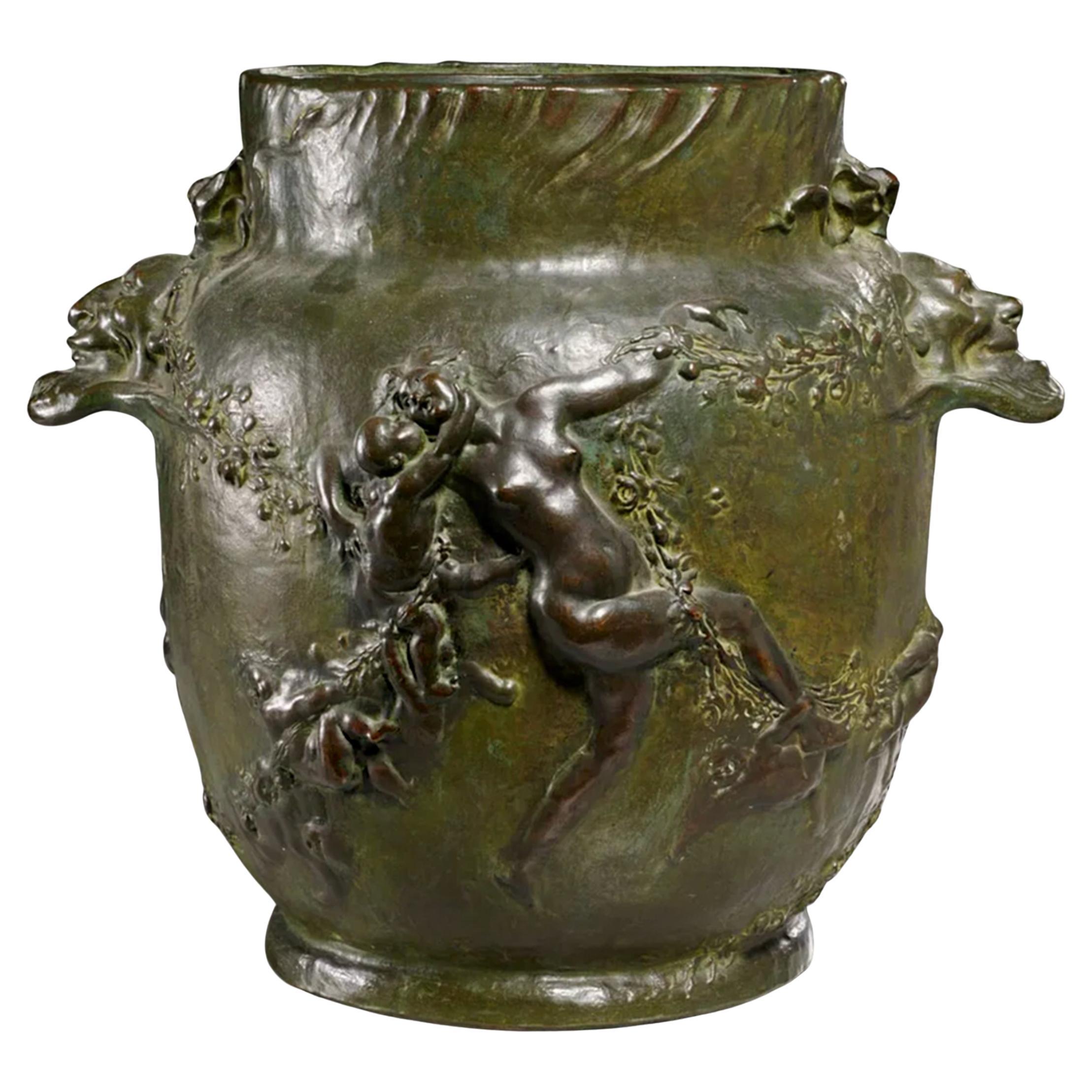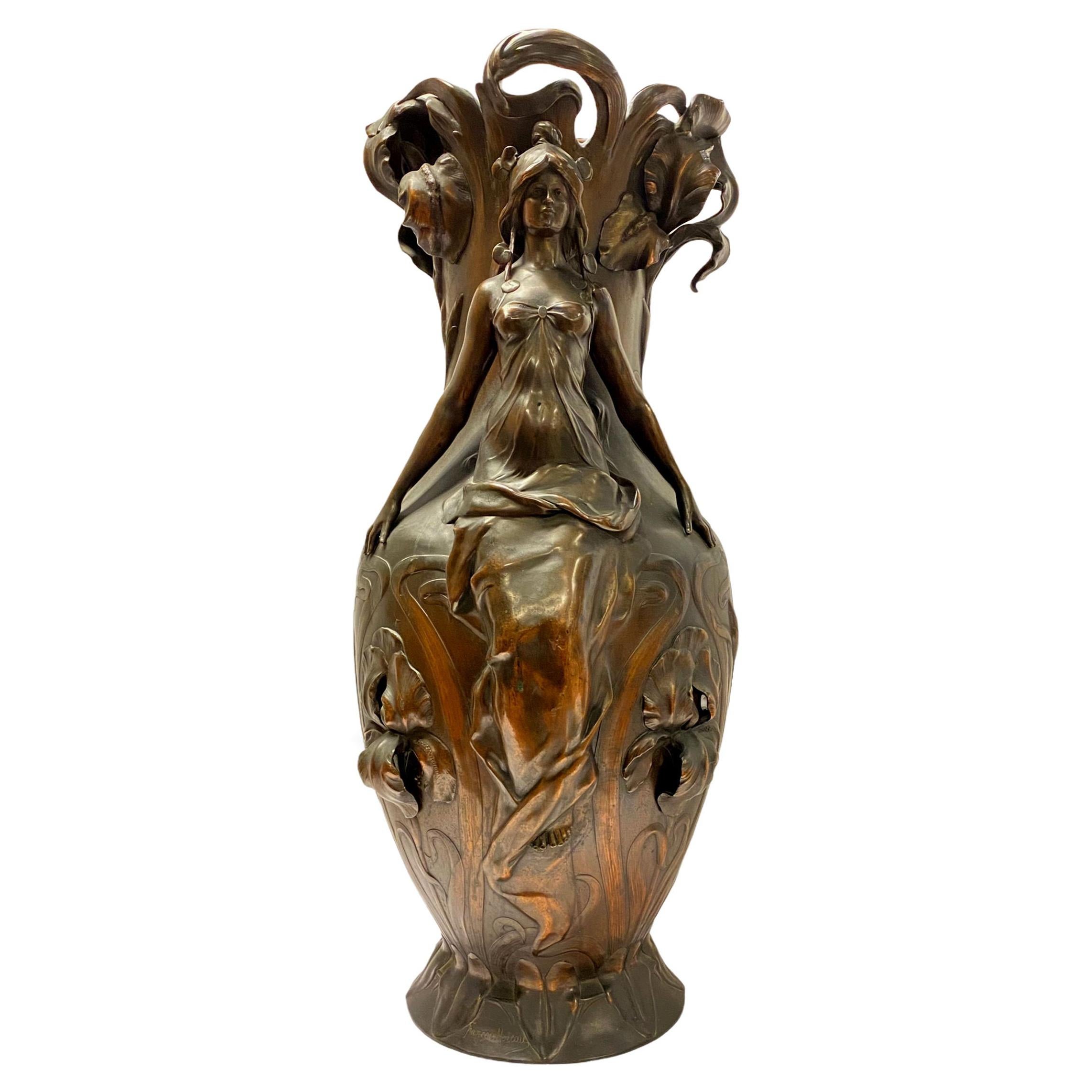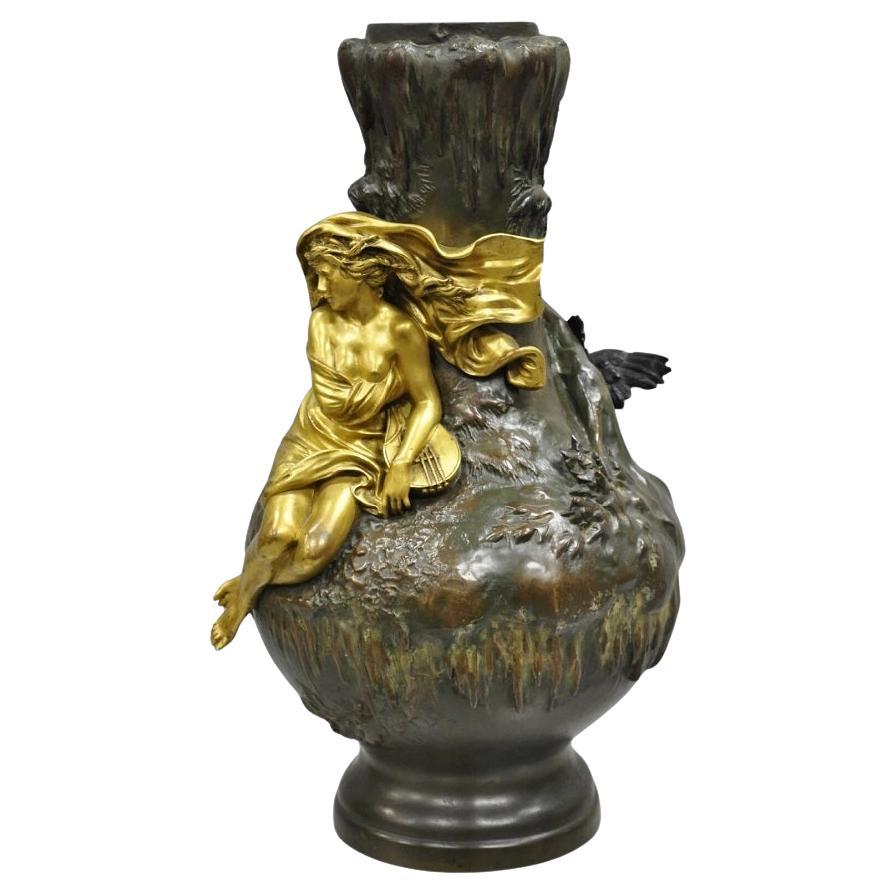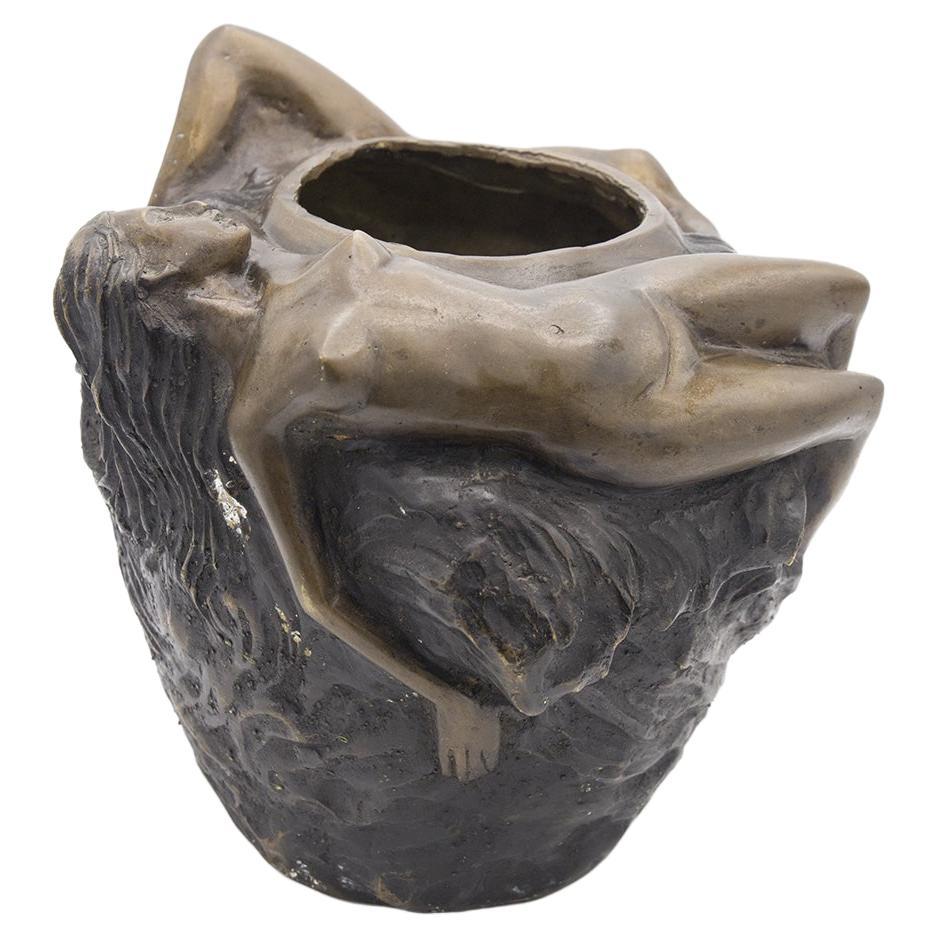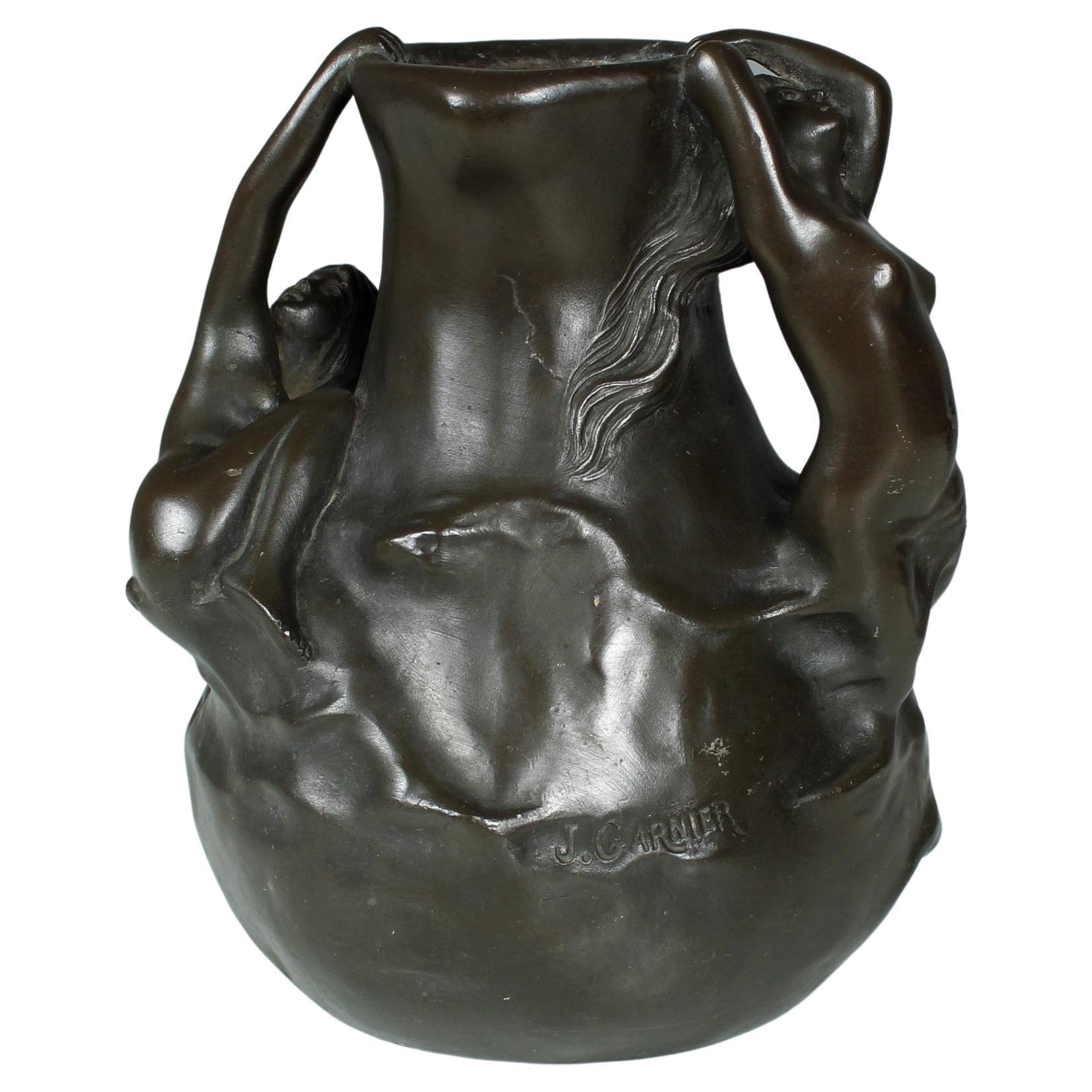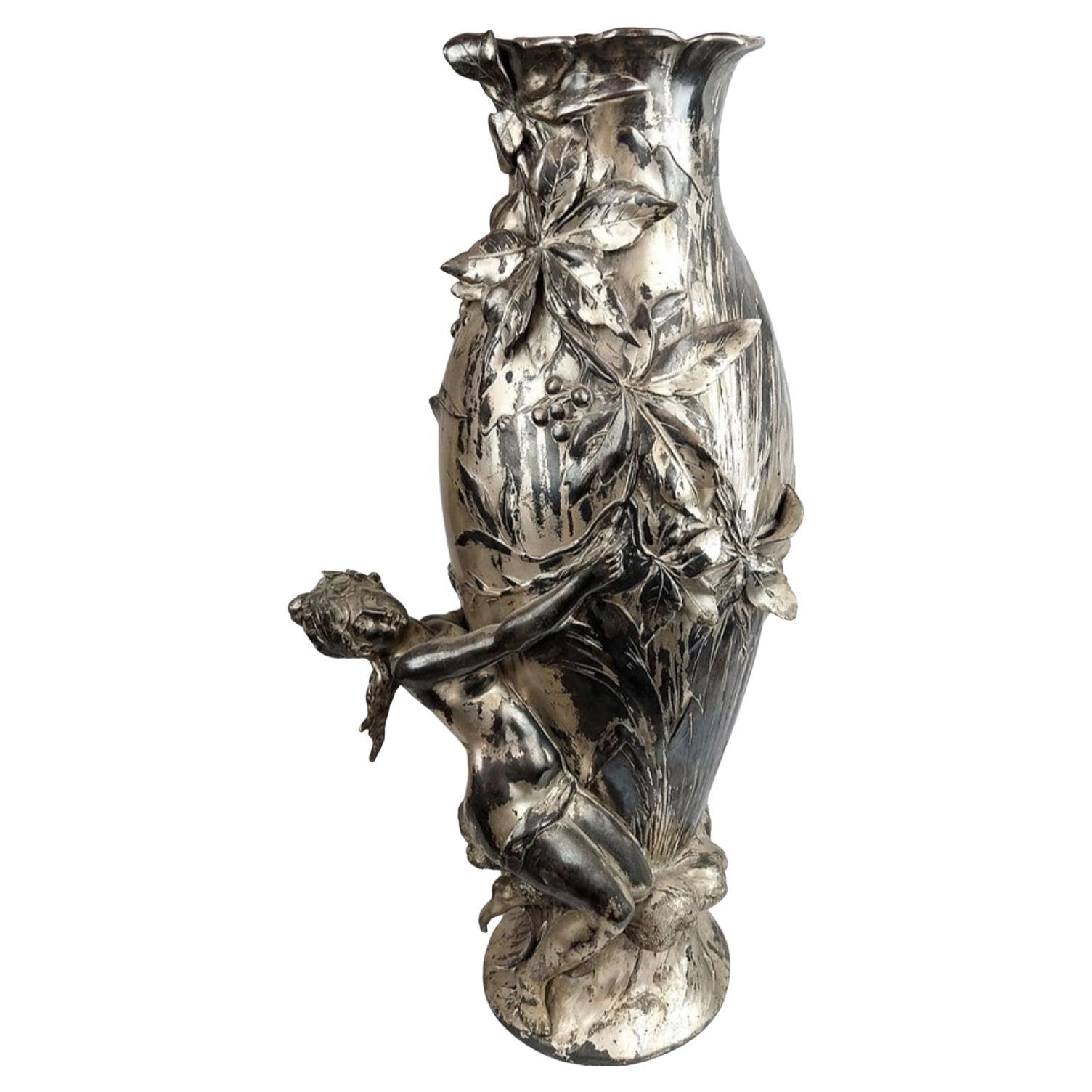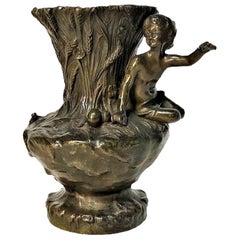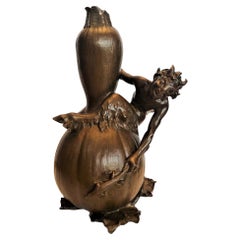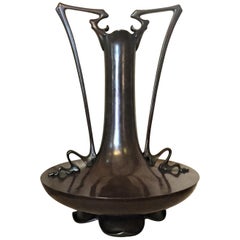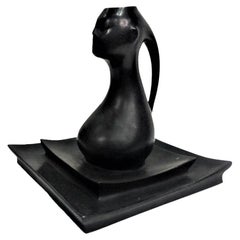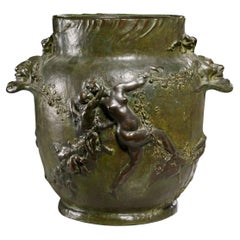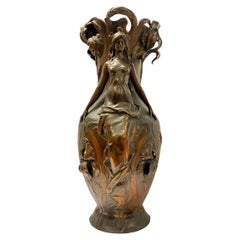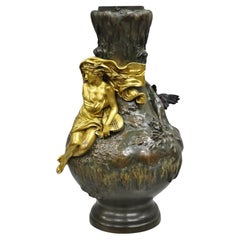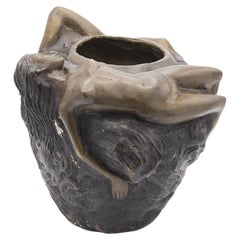Items Similar to Charles Vital-Cornu, French Art Nouveau Bronze Sculptural Floral Vase, 1900s
Want more images or videos?
Request additional images or videos from the seller
1 of 9
Charles Vital-Cornu, French Art Nouveau Bronze Sculptural Floral Vase, 1900s
$4,675
$8,50044% Off
£3,533.72
£6,424.9544% Off
€4,060.87
€7,383.4144% Off
CA$6,509.91
CA$11,836.2044% Off
A$7,242.01
A$13,167.2944% Off
CHF 3,796.35
CHF 6,902.4644% Off
MX$88,495.55
MX$160,901.0144% Off
NOK 48,341.79
NOK 87,894.1644% Off
SEK 45,507.11
SEK 82,740.1944% Off
DKK 30,312.88
DKK 55,114.3244% Off
Shipping
Retrieving quote...The 1stDibs Promise:
Authenticity Guarantee,
Money-Back Guarantee,
24-Hour Cancellation
About the Item
Charles Vital-Cornu (French, 1851 - 1927), Jouffroy’s and Pils’ pupil, he acquired a skillfulness mastery in carving marbles and producing bronzes. He used several patinas in his production. Indeed, if his pieces' embodiments are often golden-brown colored, the hollow part are darker. His figures, hands, faces, and bodies are of a great quality.
Charles Vital-Cornu had participated in numerous annual ‘‘Salons’’ organized in Paris by ‘‘la Société des Artistes Français’’ where he got several awards, such as a mention of Honor in 1880 and 1881, a third class medal in 1882, a travelling grant in 1883, a second class medal in 1886, a bronze medal at the 1889 World Fair and, finally, a silver medal at the 1900 World Fair at the Grand palace in Paris.
The works of this artist are in the permanent collections of the following world museums:
Musée d’Ajaccio : Narcisse enfant
Musée de Grenoble : Le spleen
Musée de Lausanne : Maternité 1905, bronze
Musée de Limoges : Belle vendanges
Musée Galliera, Paris : Archimède.
- Creator:Charles Vital-Cornu (Sculptor)
- Dimensions:Height: 15.75 in (40.01 cm)Diameter: 14 in (35.56 cm)
- Style:Art Nouveau (Of the Period)
- Materials and Techniques:Bronze,Patinated
- Place of Origin:
- Period:1900-1909
- Date of Manufacture:1900s
- Condition:Wear consistent with age and use. Signed by the artist and stamped with foundry mark. There is an original metal insert-vase for displaying fresh-cut flowers in water. We make our best effort to provide a fair and descriptive condition report. Please examine the photos attentively.
- Seller Location:New York, NY
- Reference Number:1stDibs: LU2819311033913
About the Seller
5.0
Vetted Professional Seller
Every seller passes strict standards for authenticity and reliability
Established in 1993
1stDibs seller since 2017
83 sales on 1stDibs
Typical response time: 7 hours
- ShippingRetrieving quote...Shipping from: New York, NY
- Return Policy
Authenticity Guarantee
In the unlikely event there’s an issue with an item’s authenticity, contact us within 1 year for a full refund. DetailsMoney-Back Guarantee
If your item is not as described, is damaged in transit, or does not arrive, contact us within 7 days for a full refund. Details24-Hour Cancellation
You have a 24-hour grace period in which to reconsider your purchase, with no questions asked.Vetted Professional Sellers
Our world-class sellers must adhere to strict standards for service and quality, maintaining the integrity of our listings.Price-Match Guarantee
If you find that a seller listed the same item for a lower price elsewhere, we’ll match it.Trusted Global Delivery
Our best-in-class carrier network provides specialized shipping options worldwide, including custom delivery.More From This Seller
View AllFrench Beaux Arts, Patinated Bronze Figural Vase by A. Bofill, Ca. 1900
By Antoine Bofill
Located in New York, NY
Antoine Bofill (Spanish-French, 1875-1925) was a Spanish artist and member of the Animalier movement of the 19th century. Best known for his small, decorative bronze sculptures, Bofi...
Category
Antique Early 1900s French Beaux Arts Vases
Materials
Bronze
Franz Xavier Bergmann, Sculptural Bud Vase, Vienna Bronze, circa 1900
By Franz Bergmann
Located in New York, NY
Dimensions
Height: 7.25 inches
Width: 5.25 inches
Depth: 4.5 inches.
Markings
Fully marked on the bottom with a "B" in an urn-shaped cartouche (for “Bergmann”), and “GESHUTZED” (German: “PROTECTED).
ABOUT
What distinguishes this unique bud vase from others is a perfect synthesis of a utilitarian object and a Fine sculpture. It is not only the amazing subtlety and taste of the author’s artist skills, but an extraordinary design and an absolutely outstanding original plot. Designed for a single flower only, it is nonetheless a very complex and multifaceted composition filled with warm humor and fantasy. Sitting on a vessel shaped as a gourd, clasping its goat legs with hooves and holding on to the neck with one hand in order not to fall of it; a playful and mischievous faun holds by the tail a fleeing lizard with the other hand.
FRANZ XAVIER BERGMANN (Austrian, 1861–1936) was the owner of a Viennese foundry who produced numerous patinated and cold-painted bronze oriental, erotic and animal figures, the latter often humanized or whimsical, humorous objects d'art. Cold painted bronze refers to pieces cast in Vienna and then decorated in several layers with so-called dust paint; the expertise for the mix of this kind of paint has been lost. The color was not fired hence "cold painted". Mainly women working...
Category
Antique Early 1900s Austrian Jugendstil Vases
Materials
Bronze
Japanese Art Nouveau Meiji Period Patinated Bronze Vase, circa 1900
Located in New York, NY
Although unmarked, this rare and important, grand but at the same exquisite patinated bronze vase has just a very few little details, defying the shape of the handles, as well as the...
Category
Antique Early 1900s Japanese Art Nouveau Vases
Materials
Bronze
Alfonso Canciani, Viennese Secession Orientalist Bronze Vase, c. 1910
By Alfonso Canciani
Located in New York, NY
Alfonso Canciani (Italian-Austrian, 1863-1955) was a famous Italian-Austrian sculptor of the period of accession to the Viennese Secession. Son of a stonemason, after a realist period he managed to establish himself as a leading sculptor of the Viennese Secession. In fact, he worked in Vienna, where he had enrolled in 1886 at the Academy of Fine Arts, then at the Higher School of Sculpture and finally at the Special School, where he obtained the Rome prize for the sketch for Dante's Monument.
He developed a notable business obtaining important prizes and numerous commissions. First among the sculptors of the Viennese capital, he was invited to join the Association of the Viennese Secession, of which Klimt was magna pars, after the exhibition of Dante's group in 1900 at the Secession exhibition, and obtained the most important Austrian artistic prize, the Kunstlerlpreis.
This same work, presented in 1910 in Berlin, at the Great Art Exhibition, also received an important recognition here. He obtained the Rome prize in 1896, exhibited successfully in Munich and in 1899 at the III International Art Exhibition in Venice.
In that period he made some statues of saints for the cathedral of Santo Stefano in Vienna, the monument to Wagner, the bust of Nietzsche for the University, the scepter and the gold chain of the University Rector, figures of Italian poets ( Petrarch, Boccaccio, Tasso, Ariosto).
He submitted a sketch for the official monument to Empress Elizabeth, which was then built in Austrisn Gföhl and Pula. At the time of his accession to the Secession, he dedicated himself to decorating the facade of the Artaria house in Vienna in collaboration with the architect Max Fabiani.
He later abandoned the symbolist decorativism of the Jugendstil for a more concentrated and vigorous style, approaching the Belgian sculptor Constantin Meunier for the theme of work, and preferring to exhibit at the Künstlerhaus.
In Vienna, he was generous with advice and help with the Italians and in particular with his fellow citizens (such as the Brazzanese Luigi Visintin, then a university student).
After the First World War, he returned to Italy and lived in Friuli, penalized by the fact that the Habsburg Empire had by now disappeared. Instead of large-scale public monuments, he then devoted himself to engraving medals (e.g. for Benedict XV and for the Italian mission in Vienna in 1919) and to designing funeral monuments (examples in Mali Lošinj and Trieste) and portrait busts (of Generals Carlo Caneva and Antonio Baldissera in Udine, sculptures of the War Memorial of Corno di Rosazzo). After all, he had already executed the Bab grave monument in the Döblinger cemetery in Vienna in 1909.
He taught in Trieste from 1920 until 1935, at the local school of industrial art, where he had Marcello Mascherini...
Category
Vintage 1910s Austrian Jugendstil Vases
Materials
Bronze
French Art Nouveau Patinated Bronze Sculptural Iris Vase, ca. 1900
Located in New York, NY
ABOUT IRIS
The iris is a special and mysterious flower. Not only because of its striking appearance, but also from an artistic and historical point of view. It is also like a work of art, as though created by Mother Nature. The unique leaves of this plant not only create wonderful shadow casts, but also look as if they were painted by hand. It's no wonder that iris acts as the muse for countless artists, and can be seen in many famous works of art.
The iris was first spotted in the time of Pharaoh Thutmose, in 1504 BC. He had the iris inscribed into the wall reliefs of a temple as a sign of his power, as well as decorating his sceptre with motifs of the flower. Since then, the iris has been a symbol of victory in Egypt. But the symbolism of the iris goes further than that. In Japan, the flower represents courage and is the symbol of the boys' festival. In Islamic cultures, the iris is a symbol of prosperity. In Europe, the flower was a popular weapon symbol in the Middle Ages and stood for chivalry. And in Christianity, the iris was seen as a symbol of the trinity because of its three-part flowers. With more than 300 varieties, the iris is now the most popular flower among growers and gardeners following the rose.
Countless artists use the iris in their works and the flower is present in all eras. You can see the flower on furniture, vases, jewelry, fabrics, sculptures, coats of arms and much more. Did you know that the iris is also called the sword lily? It's not a coincidence that it used to symbolize physical and emotional pain and suffering caused by a weapon. We also see the flower in religious art, where it's often associated with Mary and Jesus. The iris is also associated with the Greek goddess Iris, where the flower symbolizes reconciliation and divine messages. This is also reflected in many paintings.
Finally, the iris is also visible in Dutch and Flemish still-life paintings. This can be in a religious form, incorporated into an object or as a decorative flower.
In the Art Nouveau art movement, the iris (along with other plants, such as the birch) was often used as an expression of feminine beauty. With its almost otherworldly appearance, the iris is perfectly suited to the Art Nouveau aesthetic and is featured in many well-known works of art. The poet of that era, Hermann Hesse...
Category
Antique Early 1900s French Art Nouveau Planters, Cachepots and Jardinières
Materials
Bronze
Paul Loiseau-Rousseau, French Art Nouveau Gilt Bronze Jug, Ca. 1900
By Paul Loiseau-Rousseau 1
Located in New York, NY
Paul Louis Emile Loiseau-Rousseau (French, 1861-1927) was a famous French sculptor. In his youth, he planned to devote himself to etching, was a student of Antoine-Louis Barye at the...
Category
Antique Early 1900s French Art Nouveau Vases
Materials
Bronze
You May Also Like
Joseph Cheret Patinated Bronze Art Nouveau Vase
Located in New York, NY
A verdigris patinated cast bronze, relief vase decorated with maidens and putti frolcking while holding a long garland and centaur masacron handles.
Cast signed and foundry mark fo...
Category
Late 19th Century Art Nouveau Nude Sculptures
Materials
Bronze
Large Francois Moreau Art Nouveau Metal Vase
Located in New York, NY
Very large and fine quality French 19 century Francois Moreau Art Nouveau patinated white metal vase.
Category
Antique 1890s French Art Nouveau Vases
Materials
Metal
Charles Georges Ferville-Suan French Art Nouveau Gold Gilt Patinated Bronze Vase
By Charles Georges Ferville-Suan
Located in Philadelphia, PA
Antique Charles Georges Ferville-Suan (1847-1925) French Art Nouveau Gold Gilt Patinated Bronze Sculpture Vase. Item features a gold gilt bronze figure of a woman musician, birds, br...
Category
Antique Late 19th Century Unknown Art Nouveau Figurative Sculptures
Materials
Bronze
French Art Nouveau Bronze Vase
Located in Milano, IT
Beautiful French bronze vase from the Art Nouveau period, made during the early 1900s, fine French manufacture.
The vase is made entirely of bronze,...
Category
Antique Early 1900s Italian Art Nouveau Vases
Materials
Bronze
$1,341 Sale Price
20% Off
Figural Art Nouveau Vase, Signed "J. Garnier", Étain circa 1900, "En détresse"
By Jean Garnier
Located in Greven, DE
Wonderful Art Nouveau vase by the artist Jean Garnier (born in Monzeuil 1853-1910).
This art work is called "En détresse", translated as " In need".
Depicted are two nudes or so cal...
Category
Antique Early 1900s French Vases
Materials
Pewter
Art Nouveau vase by Auguste Moreau
By Auguste Moreau
Located in Belgrade, RS
This tall vase of baluster form is made of silver-plated pewter and it is the embodiment of the
charm, allure, and sophistication of the French Art Nouveau style. The vase is made an...
Category
Early 20th Century French Art Nouveau Vases
Materials
Silver Plate, Pewter
More Ways To Browse
French Bronze Vase
French Art Nouveau Vases
Art Nouveau Vase Gold
Art Nouveau Vase Bronze
Antique Face Vase
French Limoges Vase
1883 Vase
Antique Limoges Vase
Antique Limoges Vases
Limoges Art Nouveau
Cornu Bronze
Narcisse Vase
Blue Glass Italy
Browning Pottery
Blue Art Glass
Brown Pottery
Antique Hand Vase
Modern Glazed Ceramic Vases
